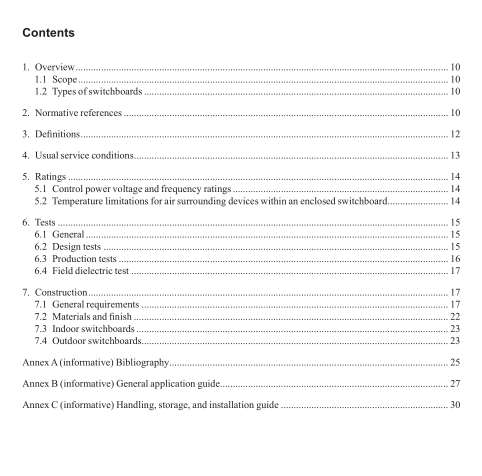IEEE C37.21-2017 pdf download.IEEE Standard for Control Switchboards
3. Defnitions
For the purposes of this document, the following terms and defnitions apply. The IEEE Standards Dictionary Online should be consulted for terms not defned in this clause.
The defnitions of terms contained in this standard, or in other standards referred to in this standard, are not intended to embrace all legitimate meanings of the terms. They are applicable only to the subject treated in this standard.
benchboard: A combination of a control desk and a vertical switchboard in a common assembly.
See also: dual benchboard and duplex benchboard.
control desk (console): A control switchboard consisting of one or more relatively short horizontal or inclined panels mounted on an assembly of such a height that the panel-mounted devices are within convenient reach of an attendant.
control switchboard: A type of switchboard including control, instrumentation, metering, protective (relays), or regulating equipment for remotely controlling other equipment. Control switchboards do not include the primary power-switching devices or their connections.
dead-front switchboard: A switchboard that has no exposed live parts on the front. dual benchboard: A combination assembly of a benchboard and a vertical hinged panel switchboard placed back to back (no aisle) and enclosed with a top and ends.
See also: benchboard and duplex benchboard. dual switchboard: A control switchboard with front and rear panels separated by a comparatively short dis- tance (no aisle) and enclosed at both ends and top. The panels on at least one side are hinged for access to the panel wiring.
See also: duplex switchboard. duplex benchboard: A combination assembly of a benchboard and vertical switchboard placed back-to-back and enclosed with a top and ends (not grille). Access space (aisle) with entry doors is provided between the benchboard and vertical switchboard. See also: benchboard and dual benchboard.
duplex switchboard: A control switchboard consisting of panels placed back-to-back and enclosed with a top and ends (not grille).
Access space (aisle) with entry doors is provided between the rows of panels.
See also: dual switchboard.
enclosed switchboard: A type of switchgear assembly that consists of one or more panels with electric devic- es mounted thereon, and associated framework.
fxed rack (cabinet): An assembly enclosed at the top and sides, either open or with door(s) for access, with a top-to-bottom front panel opening for equipment mounting [for example, 486 mm (19 in) wide chassis and subpanel assemblies]. See also: swing rack cabinet.
swing rack cabinet: An assembly enclosed at the top, sides, and rear with front hinged door for front access having a swing open frame for equipment mounting [for example, 486 mm (19 in) wide chassis in subpanel assemblies].
See also: fxed rack (cabinet). vertical switchboard: A control switchboard composed only of vertical panels. See also: vertical enclosed switchboard and vertical open switchboard.
NOTE—This type of switchboard may be enclosed or have an open back. 10 vertical enclosed switchboard: A dead-front switchboard that has an overall sheet metal enclosure (not grille) covering back, top, and ends of the entire assembly.
See also: vertical open switchboard and vertical switchboard.
NOTE 1—Access to the interior of the enclosure is usually provided by doors or removable covers.
NOTE 2—This type of switchboard may be enclosed or have an open back.
vertical open switchboard: A dead-front switchboard that has stationary panels and supporting members as required. See also: vertical enclosed switchboard and vertical switchboard.
4. Usual service conditions
Switchboards conforming to this standard shall be suitable for operation under the following usual service conditions:
a) The temperature of the cooling air (ambient air temperature) surrounding the enclosure of the switchboard is within the limits of –30 °C to +40 °C.
b) The altitude shall not exceed 2000 m above sea level.
c) The efect of solar radiation is not signifcant. (The principles stated in IEEE Std C37.24 may be used for guidance.)
d) The ambient air is not signifcantly polluted and would be classifed as having pollution level I “light”according to IEEE Std C37.100.1.
e) The conditions of humidity are as follows:
1) The average value of the relative humidity measured over a period of 24 h does not exceed 95%.
2) The average value of the water vapor pressure, over a period of 24 h does not exceed 2.2 kPa.IEEE C37.21 pdf download.IEEE C37.21-2017 pdf download
IEEE C37.21-2017 pdf download

Leave a Reply